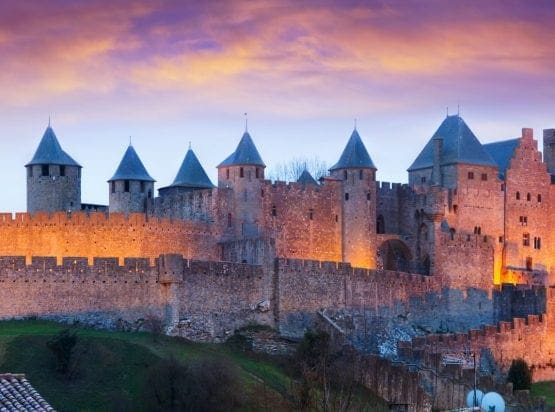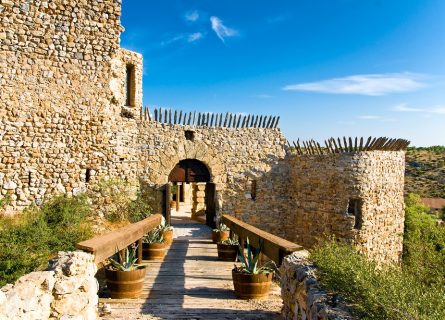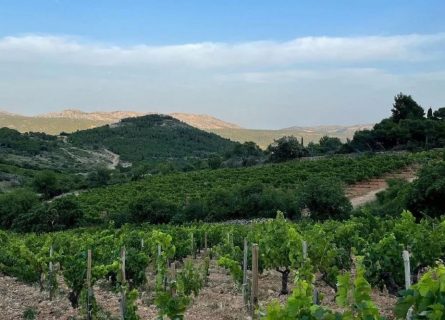Uncover Carcassonne's vibrant flavors and culinary gems with our expert guides. Plan an unforgettable trip now!
Read more
EXPLORE ALL OUR LANGUEDOC-ROUSSILLON WINE REGION GUIDE
Last updated: April 4, 2025
Fitou is one of the western Languedoc’s most dynamic and much-loved appellations. It produces a very distinct – and distinguished – interpretation of the local soils and climate: schist-covered hills to the north of Narbonne and clay-limestone slopes that flank the numerous saltwater lagoons of the region. These trend-setting reds, concentrated and yet attractively fresh, are the reason why so many sommeliers and critics have fallen in love with the flavors of southern France. And, like all great wines, they will improve immeasurably once they’re in bottle.
Discover More About French Wine

Fitou holds the singular distinction as the first Languedoc vineyard to receive appellation status in 1948. Yet there have been vines here since the days of the ancient Greeks: settlers from the Hellenic Republic called the limestone massif Leucate, a derivative of the ancient Greek word leukos or white.
They cultivated vineyards in the hills of Fitou centuries before the Romans arrived. Julius Caesar’s conquest of Gaul in the mid-last century BC absorbed their sophisticated culture into Roman civilization.
Julius Caesar’s Influence on Viticulture
As an avid wine lover, Caesar encouraged the proliferation of vines across southern France, transported to the mansions of Rome on the famous “Via Domitia” Roman road.
However, the collapse of the Western Roman Empire in the late 5th century led to multiple invasions of the Languedoc by the long-haired Germanic Visigoths and the Moors; the latter invaded Spain in 711 when Tariq landed a force of Berber and Arab mercenaries on the shores of Gibraltar.
They held the Iberian Peninsula and parts of the Languedoc until the Frankish armies counterattacked in the 8th century. After that, authorities granted Occitania considerable autonomy in its legal and administrative affairs.
Recovery and Church Influence
By the 13th century, the vineyards of Fitou had fully recovered from the upheavals of the Dark Ages. As elsewhere in Western Europe, they were controlled and managed by the Catholic Church – Cistercian monks played a key role in Languedoc viticulture from their base at the Abbey of Fontfroide.
The Golden Age of Fitou Wines
Several centuries later, the development of the Canal du Midi in the 1600s century allowed Fitou’s exceptional wines to be easily transported from the Mediterranean to the Atlantic and then on to the ports of northern Europe.
Today, Fitou is as popular with consumers internationally as it was in the 17th and 18th centuries – superb red wines that deliver excellent value. It has become an export superstar in a very crowded and competitive marketplace.

The spectacular vineyards of Fitou serve as a trusted source of richly concentrated red and sweet white wines. Yet they are an anomalous part of the Languedoc’s viticultural landscape for several reasons. The most important involves the striking bifurcation of the production zone: Fitou consists of two geographically distinct enclaves within the larger Corbieres appellation.
Indeed, over 22 kilometers of land separate them, providing each zone with a unique set of growing conditions. As a result, one bottle of Fitou can have a remarkably different flavor profile – and structure – from a similar blend made in the same vintage. This diversity of terroir makes the appellation so attractive to critics and oenophiles.
The Contrast of Fitou Maritime
Generally, the most structured and powerful wines emanate from the smaller of the two subzones: Fitou Maritime is a collection of low-lying vineyards planted on clay-limestone soils that flank the saltwater lagoons of the coast. Due to the generally low altitude (normally around 150 meters above sea level) and very warm Mediterranean climate, alcohol levels in Fitou Maritime can reach 15% in some years.
Therefore, you will occasionally encounter blowzy and unbalanced reds in the appellation. However, better canopy management and sophisticated winemaking ensure that such wines have become the minority.
Elevated Quality
Meanwhile, the aptly named Fitou Montagneux features rugged, mountainous schist terrain lying to the west of the Mediterranean. Here, the vines enjoy all the benefits of a more undulating landscape—elevation can rise to above 400 meters in some places, with relatively cool nights helping to preserve the grapes’ acidity levels.
This diurnal temperature variation, combined with exceptionally poor and free-draining soils, ensures that yields are seldom excessive in the subregion. And, without wanting to play favorites, there is a discernible freshness and precision to the best wines of Fitou Montagneux that is sometimes lacking in its coastal neighbor.
There is no tradition of producing single-varietal wines in the hills of Fitou. On the contrary, vignerons believe, most passionately, in the value of blending different grape varieties and different terroirs.
They will argue that each variety can contribute something unique and wonderful to the Grand Vin. That complexity is far more desirable than attempting to capture the essence and nuance of a single grape. It is the complete antithesis of the Burgundian “one grape, one vineyard” philosophy, and that’s how local growers like it!
The Role of Carignan and Grenache
Historically, Carignan played a role of great importance in the red wines of Fitou: low-yielding bush vines can produce exceptional quality fruit in the zone, bringing much-needed freshness and perfume to the blend. However, Grenache is now considered by many winemakers to be the appellation’s key red grape, followed by Syrah and/or Mourvedre.
According to the appellation rules, Carignan and Grenache must constitute at least 60 percent of the final blend, with a minimum of 20% of each grape. After that, it may be topped up with the noble red grape of Hermitage and the spicy, opulent Mourvedre.
Diverse Fermentation and Maturation Techniques
From this point onwards, however, the winemaker can exercise their discretion. Thus, attitudes to fermentation and maturation vary significantly in Fitou: some prefer to use destemmed crushed berries in the vat, while other winemakers favor whole bunch fermentation. The latter is said to produce wines of great perfume and finesse – a technique pioneered in Burgundy that has since been adopted worldwide.
In addition, ripe stems can add structure and grip to the wine, although this can also lead to astringency on the mid-palate. In many cases, therefore, the third way is best, partial crush and partial whole bunch, which yields wines full of flavor and bouquet.
The Choice of Aging Vessels
Of course, the choice of vessel is another key element in winemaking. Stainless steel’s cooler fermentation temperatures have many advantages: it produces a very fruit-forward and precise expression of the terroir.
However, an extended maceration will be necessary if the winemakers desire strength and depth of structure in their blend. Traditionalists strongly argue for aging such wines in old oak, believing that using new barrique interferes with and obscures the flavor, detracting from the typicité of their creations.
Yet many exceptional Fitou wines are matured in new oak – a harmonious balance of fruit and the spicy/sweet flavors that flow from barrique. As long as the different elements are fully integrated, it adds a welcome dimension to this venerable style.
In modern times, Fitou has led the vanguard for dramatic improvements in viticultural and winemaking practices in the Languedoc. This has become essential as climate change takes its toll on the region – records were broken in 2022 when growers began to pick their grapes in the hot summer mid-July sunshine.
In the 20th century, such an early harvest would have been unthinkable; September and October commencements were the norm.
Adapting with Innovation
Nonetheless, by harnessing a judicious mix of technology (producers increasingly rely on irrigation and grape ‘sunscreen’ composed of a chalky white clay solution) and sound judgment, Fitou continues to make balanced red wines despite the challenges of a warming climate.
The Evolution of Quality
Indeed, many professionals will tell you that quality has improved beyond all recognition over the past 20 years.
“I remember tasting Fitou in early 2000 and being sorely disheartened – the wines were generally heavy and rustic, lacking any finesse or terroir character,”
says sommelier Baptiste Ross-Bonneau.
“However, modern Fitou is a totally different story: softer, fresher, rounder wines with an approachability that was unheard of in the past.”
Waxing lyrical about the appellation, he describes Fitou as:
“a wine of complexity, tenderness and depth of flavor, with key stylistic differences seen across the region.”
He adds:
“For example, wines from coastal vineyards in Fitou typically have considerable weight and structure; in contrast, Fitou’s mountain vineyards situated inland produce wines of greater finesse, lighter in body and structure. So diversity is very much Fitou’s unique selling point.”
It is hard to argue with such a concise summation of Fitou’s USPs. Buoyed by ongoing investment and real innovation, the region has been elevated to the very top ranks of Languedoc appellations.
The Legacy of Dessert Wines
Yet there is more to this Mediterranean vineyard than meets the eye. Despite its overwhelming association with garrigue-scented, concentrated reds, Fitou continues to produce a small volume of exceptional dessert wine. The styles in question are Rivesaltes and Muscat de Rivesaltes: Languedoc-Roussillon’s once famous (but still relevant) Vin Doux Naturels.
In the case of the former, the wines are typically blends of Grenache Noir, Gris, and Blanc; Muscat de Rivesaltes combines the perfume of Muscat Blanc with Muscat de Alexandria’s potency to create an unctuous cacophony of rich flavors.
However, unlike Sauternes, the sweetness does not derive from the botrytis mold; the spirit is added to part-fermented grape juice (like Port), stopping the fermentation while residual sugar remains in the wine.
Vinous Heritage and Future Directions
And, like Port, aging techniques and wine styles vary dramatically. Today, these historical icons barely register in the hearts and minds of younger consumers – both in France and abroad. Nevertheless, they remain vital to Fitou’s vinous heritage, even if most oenophiles pay them no mind.
Grenache Gris is a rare, pinkish-grey variant of the red Grenache grape from southern France. Often blended into other wines, it's drought-resistant and thrives in warm climates. Wines from this grape are uncommon and offer apricot and stonefruit aromas with a full palate, resembling Viognier but without its herbal notes.
Grenache blanc is a white wine grape varietal popular in the Rhône, Châteauneuf-du-Pape and Languedoc-Roussillon regions of Southern France.
Find out moreMuscat blanc is a white wine grape varietal popular in the Muscat d'Alsace, Moscato d'Asti and Beaumes-de-Venise regions.
Find out moreCarignan is a red grape variety that grows mostly in Southern France, and is often used as a blending grape
Find out moreDiscover grenache, a mediterranean grape that is dark-skinned red wine grape variety and an unlikely hero of a grape
Find out moreMourvèdre is a red wine grape variety of mysterious origin that's grown around the world, including the Rhone and Provence regions of France.
Find out moreSyrah is dark-skinned and perhaps the most underrated of the 'noble' red grape varieties.
Find out moreLet’s deal with the drawbacks first: the petit village of Fitou is a quiet, sleepy destination that has scarcely altered over the past 50 years. Yet there are some fantastic little bistros in this timeless scene, complete with wooden shutters and well-aged bottles of Fitou planted firmly along the bar.
Feast on calf sweetbreads, sausage cassoulet, or a humble plate of delicious cured jambon (ham). As with many French dining establishments, the menu du jour at lunchtime offers a slice of local cooking at very attractive prices.
A Gastronomic Guide to the Cuisine of Languedoc Roussillon: Read more

Uncover Carcassonne's vibrant flavors and culinary gems with our expert guides. Plan an unforgettable trip now!
Read moreIf you would like us to customize an exclusive luxury tour, contact us and let us know your travel plans. We offer luxury food and wine tours for private groups of a mininium two guests. In addition, all of our private, chauffeured tours are available year-round upon request.

